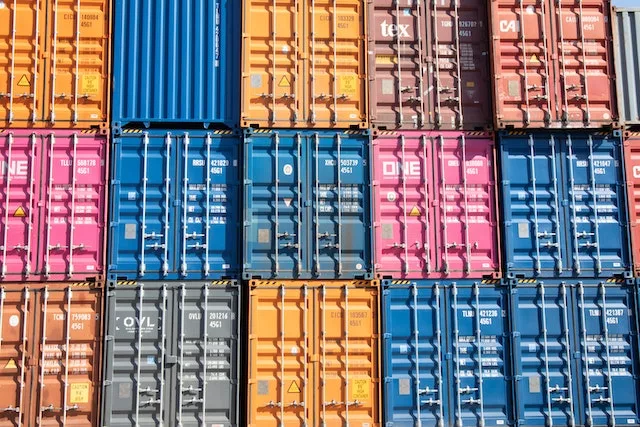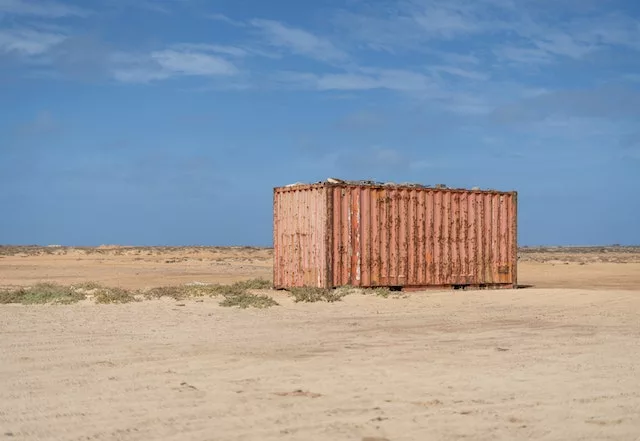Can You Legally Put a Shipping Container on Agricultural Land In The UK
Just a heads up, this post contains some affiliate links. That means that we earn a small commission if you buy the product at no extra cost to you. That allows us to continue to research and share interesting articles with you. :)
Hey there, fellow green thumbs and nature enthusiasts! Have you ever wondered if you can legally place a shipping container on agricultural land in the UK that you or someone you know owns? Well, I’ve got some fascinating information to share with you on this very topic. So, grab a cuppa and let’s dive in!
In this article, we’ll explore the ins and outs of placing a shipping container on agricultural land in the UK.

We’ll uncover the regulations and restrictions you need to be aware of, and we’ll even compare the UK’s rules with those in the US. Trust me; you will want to take advantage of this valuable information!
Last summer, my friend Sarah decided to transform her family’s unused farmland into a thriving organic garden. She had big plans to grow her own veggies, raise chickens, and live a more sustainable lifestyle.
However, she soon realised that there were legal considerations she had yet to anticipate. That’s when she delved into the world of shipping containers and discovered a whole new realm of possibilities.
So, stick around if you’re curious about the legalities, regulations, and potential benefits of placing a shipping container on agricultural land in the UK. We’ve got all the juicy details coming your way!”
Understanding the Legalities of Placing A Shipping Container on Agricultural Land
Are you wondering if placing a shipping container on your agricultural land in the UK is legal? Let’s dive into the legalities and find out!
Planning Permission
Before placing a shipping container on your agricultural land, you need to consider planning permission. Here’s what you should know:
- Permitted Development Rights: In some cases, you may be able to place a shipping container without planning permission if it falls under permitted development rights. However, there are limitations, such as size and location restrictions.
- Agricultural Buildings: If you plan to use the shipping container for agricultural purposes, it may be considered an agricultural building. You may need to apply for planning permission in this case, but it’s worth checking with your local planning authority.
Environmental Impact
When placing a shipping container on agricultural land, it’s important to consider the environmental impact. Here are some factors to keep in mind:

- Soil Health: Ensure container placement doesn’t harm the soil quality or hinder agricultural activities.
- Wildlife Protection: Consider the impact on local wildlife and take measures to protect their habitats.
Other Considerations
Before making a decision, think about the following:
- Access and Safety: Ensure that the container placement doesn’t obstruct access to your land or pose any safety risks.
- Lease or Ownership: If you’re leasing the land, check with the landowner for any restrictions or permissions required.
Product Recommendation: Shipping Container Homes for Beginners
Shipping Container Homes for Beginners” is an absolute game-changer for me. The prospect of building my sustainable dream home from the ground up, within budget, has me captivated. This guide’s step-by-step approach simplifies the process, from choosing the right container to installing utilities.
The floor plan ideas fuel my creativity, while the promise of a custom-designed, off-grid haven feels within reach, even for a novice. With each page, my dream inches closer to reality – a sustainable, uniquely mine dwelling.
Regulations and Restrictions in the UK
When it comes to placing a shipping container on agricultural land in the UK, there are certain regulations and restrictions that you need to be aware of. Here’s what you need to know:
Planning Permission
In most cases, you must obtain planning permission from your local council before placing a shipping container on agricultural land. This ensures that the development aligns with the planning policies and does not hurt the surrounding area.
Agricultural Land Use
It’s important to consider the primary use of the agricultural land. If the land is actively used for farming or other agricultural purposes, placing a shipping container may not be allowed as it could interfere with the productivity of the land.
Size and Placement
There may be restrictions on the size and placement of a shipping container on agricultural land. For example, some councils may limit the height or require a distance from property boundaries or public roads.
Environmental Considerations
The UK has strict regulations in place to protect the environment. When placing a shipping container on agricultural land, you need to ensure that it does not cause any harm to the soil, water sources, or wildlife in the area.
Historic or Conservation Areas
If your agricultural land is located in a historic or conservation area, there may be additional restrictions on any developments, including the placement of shipping containers.
Product Recommendation: Shipping Container Adjustable Feet
These adjustable feet simplify levelling, upholding containers securely against weights of up to 12,000 kg. The galvanised finish enhances durability, shielding against uneven surfaces that might lead to issues like jammed doors. With straightforward installation and a promise to protect container modifications, these feet prioritise cargo safety and offer a sense of reassurance.
Comparing UK Regulations with the US
When placing a shipping container on agricultural land, it’s important to understand the applicable regulations and restrictions. In the UK, there are specific guidelines that govern this practice, but how do they compare to the regulations in the US?
Zoning and Planning Permissions

- In the UK, planning permission is generally required for placing shipping containers on agricultural land. Local authorities assess each application on a case-by-case basis.
- In the US, zoning regulations vary by state and county. Some areas may require permits, while others have more lenient rules.
Size and Placement Restrictions
- In the UK, there are limitations on the size and placement of shipping containers. They must not exceed a certain height and should be positioned in a way that minimises visual impact.
- In the US, size and placement restrictions also vary. Some areas may have specific setback requirements or restrictions on the number of containers allowed.
Structural Modifications
- In the UK, any structural modifications to shipping containers require approval from building control authorities.
- In the US, regulations regarding structural modifications may vary. It’s important to consult local building codes before making any alterations.
While there are similarities between UK and US regulations, it’s crucial to research and understand the specific rules in your area. Consulting with local authorities or seeking legal advice can help ensure compliance.
Factors to Consider Before Placing a Shipping Container on Agricultural Land
Are you considering placing a shipping container on your agricultural land in the UK? Before you dive in, there are a few important factors to consider. Let’s take a closer look:
- Planning Permission: In most cases, placing a shipping container on agricultural land will require planning permission. It’s essential to check with your local planning authority to ensure you comply with the regulations. They will assess the container’s size, location, and visual impact on the surrounding area.
- Land Use Restrictions: Some agricultural land may have specific restrictions on what can be placed on it. For example, if your land is designated as a Site of Special Scientific Interest (SSSI), structures may have limitations that could impact the natural habitat. It’s crucial to understand any land use restrictions before proceeding.
- Structural Considerations: Shipping containers are sturdy, but you must ensure that your land can support the weight. Consider factors such as the ground conditions, drainage, and any potential impact on nearby structures or utilities.
- Accessibility: Think about how the shipping container will be accessed. Will you need to create a new access road or modify an existing one? Ensure that the container’s placement doesn’t hinder the movement of vehicles or machinery on your land.
- Security and Safety: Shipping containers can provide secure storage, but it’s essential to consider additional security measures. Consider installing locks, alarms, or CCTV systems to protect your belongings. Safety is also crucial, so ensure the container is properly ventilated and insulated if necessary.
Environmental Impact and Sustainability Considerations
When considering placing a shipping container on agricultural land in the UK, it’s important to consider the environmental impact and sustainability factors. As someone who cares about living a wholesome and eco-friendly life, you want to ensure that your actions align with your values. Here are some key points to consider:
- Soil Health: Placing a shipping container on agricultural land can impact the soil beneath it. The weight of the container may compact the soil, affecting its ability to absorb water and nutrients. However, this can be mitigated by using proper foundation techniques and ensuring adequate drainage.
- Biodiversity: Agricultural land is often home to various plant and animal species. Placing a shipping container may disrupt their habitats and affect local biodiversity. It’s important to assess the potential impact and take steps to minimise any negative effects.
- Sustainable Materials: Shipping containers are typically made from highly durable and recyclable steel. By repurposing a a shipping container on agricultural land, you are giving it a second life and reducing waste. Consider using eco-friendly paints and insulation materials to further enhance sustainability.
- Energy Efficiency: Shipping containers can be modified to be energy-efficient with insulation, solar panels, and rainwater harvesting systems. This allows you to reduce your carbon footprint and live a more self-reliant and sustainable lifestyle.
By considering the environmental impact and sustainability factors, you can make an informed decision about placing a shipping container on your agricultural land.
In the next section, we will explore the potential benefits of this practice and provide you with real-life case studies to inspire and guide you. Keep reading to discover how shipping containers can transform your agricultural endeavours!
Potential Benefits of Placing Shipping Containers on Agricultural Land
So, you’re considering placing a shipping container on your agricultural land in the UK? Well, my friend, some fantastic benefits come along with this eco-friendly and innovative idea. Let’s dive in and explore the potential advantages:

- Versatility: Shipping containers can be transformed into various structures, such as storage sheds, workshops, or even cosy retreats. The possibilities are endless!
- Cost-effective: Compared to traditional building methods, a shipping container can save you significant money. Plus, you’ll be repurposing a sturdy structure that would otherwise go to waste.
- Mobility: If you like to change things up or move around your land, shipping containers offer the flexibility to easily transport to different locations.
- Sustainability: You’re contributing to a more sustainable future by repurposing shipping containers. It’s a win-win situation for both you and the environment.
- Security: Shipping containers are built to withstand harsh conditions, making them incredibly secure. You can rest easily knowing your belongings or equipment are safe and protected.
Conclusion: Making an Informed Decision
So, after diving into the legalities and regulations surrounding placing a shipping container on agricultural land in the UK, it’s time to make an informed decision. Here are some key points to consider:
- Familiarise Yourself with Local Regulations: Before taking any action, it’s crucial to research and understand the specific regulations and restrictions in your local area. Contact your local council or planning department to get accurate information.
- Assess the Environmental Impact: Consider the potential environmental impact of placing a shipping container on agricultural land. Consider factors such as soil health, water drainage, and the impact on local wildlife. It’s important to prioritise sustainability and minimise any negative effects.
- Evaluate the Benefits: Shipping containers can offer various benefits on agricultural land. They provide secure storage for tools and equipment, can be converted into functional spaces like workshops or offices, and even serve as temporary animal shelters. Assess how these benefits align with your needs and goals.
- Consider Alternative Options: If placing a shipping container on your agricultural land is not feasible or doesn’t align with your values, explore alternative options. Look into eco-friendly storage solutions, sustainable building materials, or other creative ideas that meet your requirements.
- Seek Professional Advice: If you need clarification on placing a shipping container on your agricultural land, seeking professional advice is always a good idea. Consult with architects, planners, or agricultural experts who can provide guidance based on your specific circumstances.
Making an informed decision is crucial when using a shipping container on agricultural land. By considering the legalities, regulations, environmental impact, and alternative options, you can ensure that your decision aligns with your values of sustainability, self-reliance, and a wholesome lifestyle.
Happy gardening, and may your agricultural endeavours be fruitful and fulfilling!
Back To The Good Life is a participant in the Amazon Services LLC Associates Program, an affiliate advertising program designed to provide a means for sites to earn advertising fees by advertising and linking to Amazon.com. We also participate in other affiliate programs which compensate us for referring traffic.







